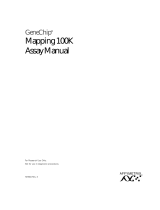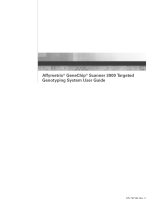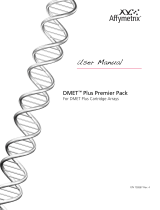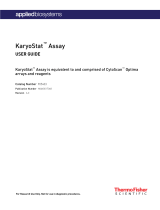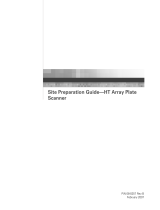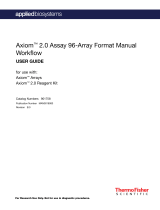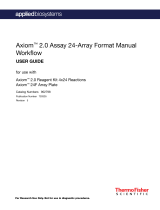Page is loading ...

P/N 701930 Rev. 3
GeneChip® Mapping 500K Assay Manual

For research use only.
Not for use in diagnostic procedures.
Trademarks
Affymetrix®, , GeneChip®, HuSNP®, GenFlex®, Flying Objective™,
CustomExpress®, CustomSeq®, NetAffx™, Tools to Take You As Far As Your Vision®,
The Way Ahead™, Powered by Affymetrix™, and GeneChip-compatible™ are
trademarks of Affymetrix, Inc.
All other trademarks are the property of their respective owners.
Limited License
Subject to the Affymetrix terms and conditions that govern your use of Affymetrix
products, Affymetrix grants you a non-exclusive, non-transferable, non-
sublicensable license to use this Affymetrix product only in accordance with the
manual and written instructions provided by Affymetrix. You understand and agree
that except as expressly set forth in the Affymetrix terms and conditions, that no
right or license to any patent or other intellectual property owned or licensable by
Affymetrix is conveyed or implied by this Affymetrix product. In particular, no right or
license is conveyed or implied to use this Affymetrix product in combination with a
product not provided, licensed or specifically recommended by Affymetrix for such
use.
Patents
Arrays: Products may be covered by one or more of the following patents and/or sold
under license from Oxford Gene Technology: U.S. Patent Nos. 5,445,934; 5,700,637;
5,744,305; 5,945,334; 6,054,270; 6,140,044; 6,261,776; 6,291,183; 6,346,413; 6,399,365;
6,420,169; 6,551,817; 6,610,482; 6,733,977; and EP 619 321; 373 203 and other U.S. or
foreign patents.
Copyright
© 2005–2006 Affymetrix Inc. All rights reserved.

iii
Contents
CHAPTER 1 Overview 1
ABOUT THIS MANUAL 3
ABOUT WHOLE GENOME SAMPLING ANALYSIS 4
REFERENCES 8
CHAPTER 2 Laboratory Setup 19
INTRODUCTION TO LABORATORY SETUP 21
PRE-PCR CLEAN ROOM 22
PCR STAGING ROOM 22
MAIN LAB 23
SAFETY PRECAUTIONS 24
CHAPTER 3 Genomic DNA General Requirements 25
INTRODUCTION 27
GENERAL REQUIREMENTS FOR HUMAN GENOMIC DNA 27
SOURCES OF HUMAN GENOMIC DNA 29
GENOMIC DNA EXTRACTION/PURIFICATION METHODS 29
DNA CLEANUP 29
REFERENCES 30

iv GeneChip® Mapping 500K Assay Manual
CHAPTER 4 96-Well Plate Protocol 33
96-WELL PLATE PROTOCOL 35
About This Protocol 35
BEFORE YOU BEGIN 38
Master Mix Preparation 38
Reagent Handling and Storage 38
Preparing the Work Area for Each Stage 39
thermal Cyclers, Plates and Plate Seals 40
PRogram Your Thermal Cyclers 41
Cutting Strip Tubes From Plates 41
STAGE 1: GENOMIC DNA PLATE PREPARATION 42
About this Stage 42
Location and Duration 42
Input Required 42
Equipment and Consumables Required 43
Reagents Required 44
Preparing the Genomic DNA Plate 44
Aliquoting Prepared Genomic DNA 45
What You Can Do Next 45
STAGE 2: RESTRICTION ENZYME DIGESTION 46
About this Stage 46
Location and Duration 46
Input Required From Previous Stage 46
Equipment and Consumables Required 46
Reagents Required 48
Important Information About This Stage 48
Prepare the Reagents, Equipment and Consumables 49
Prepare the Digestion Master Mix 50
Add Digestion Master Mix to Samples 51
STAGE 3: LIGATION 53
About this Stage 53
Location and Duration 53
Input Required From Previous Stage 53

contents v
Equipment and Consumables Required 54
Reagents Required 55
Important Information About This Procedure 55
Prepare the Reagents, Consumables and Other Components 55
Prepare the Ligation Master Mix 57
Add Ligation Master Mix to Reactions 58
Dilute the Samples 59
What You Can Do Next 60
STAGE 4: PCR 61
About this Stage 61
Location and Duration 61
Input Required from Previous Stage 61
Equipment and Materials Required 62
Reagents Required 63
Gels and Related Materials Required 64
Important Information About This Stage 64
Prepare the Reagents, Consumables and Other Components 65
Add DNA to the Reaction Plates 66
Prepare the PCR Master Mix 68
Add PCR Master Mix to Samples 69
Load PCR Plates Onto Thermal Cyclers 70
Running Gels 72
What You Can Do Next 73
STAGE 5: PCR PRODUCT PURIFICATION AND ELUTION 74
About this Stage 74
Location and Duration 74
Input Required from Previous Stage 74
Equipment and Consumables Required 75
Reagents Required 76
Important Information About This Stage 76
Prepare the Reagents, Consumables and Other Components 77
Add Diluted EDTA to the PCR Products 78
Prepare the Clean-Up Plate 78
Pool the PCR Products 79
Purify the PCR Products 80
Elute The PCR Products 82
What You Can Do Next 83
STAGE 6: QUANTITATION AND NORMALIZATION 84
About this Stage 84
Location and Duration 84

vi GeneChip® Mapping 500K Assay Manual
Input Required from Previous Stage 84
Equipment and Consumables Required 84
Reagents Required 85
Important Information About This Stage 86
Prepare the Reagents, Equipment and Consumables 87
Prepare Diluted Aliquots of Purified Sample 88
Quantitate the Diluted PCR Product 90
Assess the OD Readings 90
Normalize the Samples 94
What You Can Do Next 95
STAGE 7: FRAGMENTATION 96
About this Stage 96
Location and Duration 96
Input Required from Previous Stage 96
Equipment and Consumables Required 97
Reagents Required 98
Gels and Related Materials Required 98
Important Information About This Stage 99
Prepare the Reagents, Consumables and Other Components 100
Prepare the Samples for Fragmentation 102
What You Can Do Next 105
Check the Fragmentation Reaction 106
STAGE 8: LABELING 107
About this Stage 107
Location and Duration 107
Input Required from Previous Stage 107
Equipment and Consumables Required 107
Reagents Required 109
Important Information About This Stage 109
Prepare the Reagents, Consumables and Other Components 109
Prepare the Labeling Master Mix 110
Add the Labeling Master Mix to the Samples 111
What You Can Do Next 113
STAGE 9: TARGET HYBRIDIZATION 114
About this Stage 114
Location and Duration 115
Input Required from Previous Stage 115
Equipment and Consumables Required 115

contents vii
Reagents Required 118
Important Information About This Stage 118
Prepare the Reagents, Consumables and Other Components 120
Preheat the Heat Blocks 121
Prepare the Arrays 122
Prepare the Hybridization Master Mix 122
Hybridizing Samples Using a Thermal Cycler 124
Hybridizing Samples Using Heat Blocks 130
CHAPTER 5 Washing, Staining, and Scanning Arrays 133
INTRODUCTION 135
REAGENTS AND MATERIALS REQUIRED 136
REAGENT PREPARATION 137
EXPERIMENT AND FLUIDICS STATION SETUP 139
Step 1: Registering a New Experiment in GCOS 139
Step 2: Preparing the Fluidics Station 140
PROBE ARRAY WASH AND STAIN 142
Washing and Staining the Probe Array Using FS-450 146
PROBE ARRAY SCAN 148
Handling the GeneChip® Probe Array 149
Scanning the Probe Array 150
SHUTTING DOWN THE FLUIDICS STATION 152
CHAPTER 6 Fluidics Station Care and Maintenance 153
INTRODUCTION 155
Instrument Care 155
Instrument Maintenance 155
FLUIDICS STATION BLEACH PROTOCOL 156
The Bleach Cycle 156
The Rinse Cycle 162

viii GeneChip® Mapping 500K Assay Manual
TROUBLESHOOTING AND ASSISTANCE 168
Troubleshooting Decision Tree 168
Problems and Solutions 171
Meaning of Error Messages 174
Other Problems and Solutions 176
Instrument Specifications 178
CHAPTER 7 Analysis Workflow 179
INTRODUCTION 181
SOFTWARE REQUIREMENTS 181
ANALYSIS WORKFLOW 181
ANALYSIS 182
Output 184
Report 186
GTYPE Additional Functionality 188
Import Sample Attributes 188
File Sets 189
Examining the Raw Probe Data 190
Export 190
NetAffx™ SNP Annotation 193
ASSESSING DATA QUALITY 194
Call Rate 195
Detecting Sample Contamination 197
Oligonucleotide Controls 200
Sample Mismatch report 200
B2 Oligo Performance 203
Concordance with Reference Genotypes on Reference
Genomic DNA 103 204
Downstream Analysis Considerations 206

contents ix
CHAPTER 8 Troubleshooting 209
ASSAY RECOMMENDATIONS 211
TROUBLESHOOTING GUIDE FOR THE GENECHIP® MAPPING 500K
ASSAY 214
OD TROUBLESHOOTING GUIDELINES 218
WHEN TO CONTACT TECHNICAL SUPPORT 221
APPENDIX A Reagents, Equipment, and Consumables
Required for 96-Well Plate Protocol 223
REAGENTS, EQUIPMENT, AND CONSUMABLES REQUIRED FOR
96-WELL PLATE PROTOCOL 225
About this Appendix 225
REAGENTS 226
Affymetrix Reagents Required 226
New England Biolabs Reagents Required 227
Other Reagents Required 228
EQUIPMENT AND SOFTWARE REQUIRED 229
Affymetrix Equipment and Software Required 229
Other Equipment Required 230
Thermal Cyclers, PCR Plates and Plate Seals 232
CONSUMABLES REQUIRED 233
GeneChip® Arrays Required 233
Other Consumables Required 233
SUPPLIER CONTACT LIST 235

x GeneChip® Mapping 500K Assay Manual
APPENDIX B Thermal Cycler Programs 237
THERMAL CYCLER PROGRAMS 239
About this Appendix 239
500K Digest 239
500K Ligate 239
500K PCR 240
500K Fragment 241
500K Label 241
500K Hyb 241
APPENDIX C Low Throughput Protocol 243
INTRODUCTION 245
Assay Overview 246
Before You Begin 247
GENOMIC DNA PREPARATION 248
Preparation of Genomic DNA 248
Reagents 248
STEP 1: REAGENT PREPARATION AND STORAGE 248
STEP 2: RESTRICTION ENZYME DIGESTION 249
Reagents and Equipment 249
Digestion Procedure 251
Pre-PCR Clean Area 251
PCR Staging Area 252
STEP 3: LIGATION 253
Reagents and Equipment 253
Ligation Procedure 254
Pre-PCR Clean Area 254
PCR Staging Area 255

contents xi
STEP 4: PCR 257
Reagents and Equipment 257
PCR Procedure 259
Pre-PCR Clean Room 259
PCR Staging Area 260
Main Lab 261
STEP 5: PCR PURIFICATION AND ELUTION WITH
CLONTECH CLEAN-UP PLATE 263
Reagents and Equipment 263
STEP 6: QUANTIFICATION OF PURIFIED PCR PRODUCT 266
STEP 7: FRAGMENTATION 267
Reagents and Equipment 267
Main Lab 268
Fragmentation Procedure 269
STEP 8: LABELING 274
Reagents 274
Labeling Procedure 275
Main Lab 275
STEP 9: TARGET HYBRIDIZATION 277
Reagents 277
Reagent Preparation 278
Hybridization Procedure 279
APPENDIX D Reagents, Instruments, and Supplies Required
for Low Throughput Protocol 283
INTRODUCTION 286
REAGENTS AND INSTRUMENTS REQUIRED 287
SUPPLIER CONTACT LIST 300

xii GeneChip® Mapping 500K Assay Manual

Chapter 1Overview

3
About This Manual
This manual is a guide for technical personnel conducting GeneChip®
Mapping 500K experiments in the laboratory. It contains protocols
for sample preparation, 96-well plate sample processing, and low
throughput sample processing. It also includes instructions for
washing, staining, and scanning arrays and generating genotype calls,
as well as extensive troubleshooting information. A description of each
chapter follows.
Chapter 1: Scientific Overview: A description of the overall concept
behind the GeneChip Mapping assay, including the biochemical
process, data generation, potential applications, and a list of references.
Chapter 2: Laboratory Setup: An explanation of the appropriate
laboratory configuration for running GeneChip Mapping 500K
experiments including how to set up a workflow to minimize the
possibility of carryover contamination.
Chapter 3: Genomic DNA Preparation: The requirements for
genomic DNA, with recommended sources and methods for
purification and quantitation.
Chapter 4: 96-Well Plate Protocol: Detailed, step-by-step protocol
for processing a full 96-well plate of human genomic DNA samples.
Chapter 5: Washing, Staining, and Scanning: Basic protocols for
fluidics station and scanner operation.
Chapter 6: Fluidics Station Maintenance Procedures: Describes a
weekly fluidics station bleach protocol and a monthly fluidics station
decontamination protocol.
Chapter 7: Analysis Workflow and Guidelines for Assessing
Sample and Data Quality: Describes the analysis workflow in
GeneChip® Operating Software (GCOS) and GeneChip® Genotyping
Analysis Software (GTYPE), and provides information for assessing
data quality.
Chapter 8: Troubleshooting: Additional guidelines for obtaining
optimal assay results including troubleshooting tips.
Appendix A: Reagents, Equipment, and Supplies Required for
96-Well Plate Protocol: Includes vendor and part number
information for the equipment and reagents required to run the
96-Well Plate Protocol.

4 GeneChip® Mapping 500K Assay Manual
Appendix B: Thermal Cycler Programs Required for 96-Well
Plate Protocol: Includes a list of the thermal cycler programs
required for the 96-Well Plate Protocol.
Appendix C: Low Throughput Protocol: Detailed, step-by-step
protocol for low throughput human genomic DNA sample processing.
Included is a description of quality control checkpoints at various
stages of the protocol which enable array performance to be monitored.
Appendix D: Reagents, Instruments, and Supplies Required for
Low Throughput Protocol: A complete list of the equipment and
reagents required to run the Low Throughput Protocol.
About Whole Genome Sampling Analysis
Long before the completion of the sequence of the human genome, it
was clear that sites of genetic variation could be used as markers to
identify disease segregation patterns among families. This approach
successfully led to the identification of a number of genes involved in
rare, monogenic disorders [1]. Now that the genome sequence has
been completed and is publicly available [2, 3], attention has turned
to the challenge of identifying genes involved in common, polygenic
diseases [4, 5]. The markers of choice that have emerged for whole-
genome linkage scans and association studies are single nucleotide
polymorphisms (SNPs). Although there are multiple sources of
genetic variation that occur among individuals, SNPs are the most
common type of sequence variation and are powerful markers due to
their abundance, stability, and relative ease of scoring [6]. Current
estimates of the total human genetic variation suggest that there are
over 7 million SNPs with a minor allele frequency of at least 5% [7].
The ongoing international effort to build a haplotype map will
identify a standard set of common-allele SNPs that are expected to
provide the framework for new genome-wide studies designed to
identify the underlying genetic basis of complex diseases, pathogen
susceptibility, and differential drug responses [8, 9]. Genome-wide
association studies, which are based on the underlying principle of
linkage disequilibrium (LD) in which a disease predisposing allele co-
segregates with a particular allele of a SNP, have been hampered by
the lack of whole-genome genotyping methodologies [10]. As new
genotyping technologies develop, coupled with ongoing studies into

chapter 1 | Overview 5
LD patterns and haplotype block structure across the genome,
improvements in the design and power of association studies will be
feasible [11-18].
We have developed an assay termed whole-genome sampling analysis
(WGSA) for highly multiplexed SNP genotyping of complex DNA
[19, 20]. This method reproducibly amplifies a subset of the human
genome through a single primer amplification reaction using
restriction enzyme digested, adaptor-ligated human genomic DNA.
In contrast, many alternative genotyping technologies depend on
multiple (2 to 6) locus-specific oligonucleotides per SNP, which often
precludes scaling due to cost and technical difficulty to the magnitude
required for linkage and association studies. This assay was first
developed for simultaneous genotyping of over 10,000 SNPs on a
single array (GeneChip® Human Mapping 10K Array Xba 142 2.0)
and has been used to date for both linkage studies [21-34] and
association studies [35-39]. Recently, the WGSA assay has been
extended to allow highly accurate SNP genotyping of over 100,000
SNPs using the two array GeneChip® Human Mapping 100K Set
[40]. With an average inter-marker distance of 23.6 kb, the arrays
provide increasingly dense coverage for whole-genome association
studies [41]. Recently, landmark breakthroughs in age-related
macular degeneration and multiple sclerosis provide additional
examples that this approach has now been proven to work for whole-
genome association studies [42, 43]. The same characteristics that
make SNPs useful markers for genetic studies also make SNPs
powerful markers for additional biological applications such as the
analysis of DNA copy number changes which include but are not
limited to loss of heterozygosity (LOH), deletions, and gene
amplifications [44-55]. Furthermore, integration of DNA copy
number changes with gene expression changes provides a powerful
paradigm for elucidating gene function [56].With the recent
identification of large-scale copy number polymorphisms in the
human genome as well, it is increasingly clear that a detailed
understanding of the role of genomic alterations and structure will be
important in the context of both the normal and disease state [57-60],
and the high-resolution of the genotyping arrays should prove
valuable in this arena. Additionally, large-scale SNP genotyping
provides the basis for complex studies on population and admixture
structure [61, 62].

6 GeneChip® Mapping 500K Assay Manual
The third-generation product in the mapping portfolio, the
GeneChip® Human Mapping 500K Array Set, also uses the WGSA
assay that has been the hallmark characteristic of all previous mapping
arrays. An outline of the assay steps is shown in Figure 1.1 and Figure
1.2. By changing the choice of the restriction enzymes used in WGSA,
and therefore the complexity of the resulting PCR products, along
with an increase in the information capacity of the high-density arrays
themselves, genotyping of 500,000 SNPs has been enabled on two
arrays. This increase in the number of SNPs allows for higher density,
genome-wide mapping sets, which in turn will increase the amount of
information that can be extracted for association studies, the
identification of DNA copy number alterations, and population sub-
structure. Estimates for the number of SNPs that need to be genotyped
for whole-genome association studies using large population based
samples range from 100,000 to 1,000,000 depending on the disease,
population or number of samples being studied [63-66]. In order to
leverage the power of SNPs in genetic studies, we have developed a
DNA target preparation method that, when combined with allelic
discrimination via hybridization and with an automated genotype
calling algorithm [67], allows rapid and accurate genotypic
information at a fraction of the cost of current approaches. The
Mapping 500K Set thus provides a powerful, flexible, cost-effective
approach for scoring SNP genotypes in large numbers of samples and
will provide a new technological paradigm for the design of whole-
genome association studies.

chapter 1 | Overview 7
Figure 1.1
GeneChip® Mapping Assay - Nsp I
Figure 1.2
GeneChip® Mapping Assay - Sty I

8 GeneChip® Mapping 500K Assay Manual
References
1. Botstein, D., White, R. L., Skolnick, M., Davis R.W.
Construction of a genetic linkage map in man using restriction
fragment length polymorphisms. Am J Hum Genet 32:314-31
(1980).
2. Lander, E. S., Linton, L. M., Birren, B., Nusbaum, C., Zody, M.C.,
Baldwin, J., Devon, K., Dewar, K., Doyle, M., FitzHugh W., al.
e: Initial sequencing and analysis of the human genome. Nature
409:860-921 (2001).
3. Venter, J.C., Adams, M.D., Myers, E.W., Li, P.W., Mural, R.J.,
Sutton, G.G., Smith, H.O., Yandell, M., Evans, C.A., Holt, R.A.,
al. e: The sequence of the human genome. Science 291:1304-51
(2001).
4. Botstein, D., Risch, N. Discovering genotypes underlying human
phenotypes: past successes for mendelian disease, future
approaches for complex disease. Nat Genet 33 Suppl:228-37
(2003).
5. Carlson, C.S., Eberle, M.A., Kruglyak, L., Nickerson, D.A.:
Mapping complex disease loci in whole-genome association
studies. Nature 429:446-52 (2004).
6. Wang, D.G., Fan, J.B., Siao, C.J., Berno, A., Young, P., Sapolsky,
R., Ghandour, G., Perkins, N., Winchester, E., Spencer, J., et al.
Large-scale identification, mapping, and genotyping of single-
nucleotide polymorphisms in the human genome. Science
280:1077-82 (1998).
7. Kruglyak, L., Nickerson, D.A. Variation is the spice of life. Nat
Genet 27:234-6 (2001).
8. Gibbs, R.A., Belmont, J.W., Hardenbol, P., Willis, T.D., Yu, F.,
Yang, H., Ch'ang, L-Y, Huang, W., Liu, B., Shen, Y., al. e: The
International HapMap Project. Nature 426:789-96 (2003).
9. Sachidanandam, R., Weissman, D., Schmidt, S.C., Kakol, J.M.,
Stein, L.D., Marth, G., Sherry, S., Mullikin, J.C., Mortimore, B.J.,
Willey, D.L., Hunt, S.E., Cole, C.G., Coggill, P.C., Rice, C.M.,
Ning, Z., Rogers, J., Bentley, D.R., Kwok, P.Y., Mardis, E.R.,
Yeh, R.T., Schultz, B., Cook, L., Davenport, R., Dante, M.,
Fulton, L., Hillier, L., Waterston, R.H., McPherson, J.D.,
/

